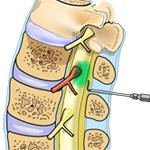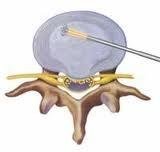The vast majority of symptoms related to spinal conditions can be treated conservatively with relative rest, education, activity, and/or work modification, bracing, medication, and/or active physical rehabilitation. These measures are almost always incorporated into the treatment program of spinal conditions as they empower patients to be proactive with acute management and can be crucial in achieving long-term success.
Short periods of relative rest and/or restriction or modification of certain activities may be prescribed depending on any given patient’s diagnosis and unique work or lifestyle.
Bracing may be required for certain types of spinal conditions, most commonly to stabilize spinal fractures post-operatively.
The utilization of heat, ice, mild electrical stimulation, ultrasound, relaxation techniques, pool therapy, etc. may be recommended for certain spinal conditions and commonly associated adjuvant conditions.
Medication may be utilized to assist in pain tolerance, muscle spasm control, and sleep deprivation in order to facilitate physical rehabilitation and functioning.
Diagnosis-specific physical therapy programs are commonly prescribed with a physical therapist who has expertise in the rehabilitation of spinal conditions to help maximize patient function and return to an active lifestyle. This includes Exercise programs and Yoga therapy protocols.
 A facet injection is a minimally invasive procedure that can temporarily relieve neck or back pain caused by inflamed facet joints. The cause of facet joint pain (arthritis, injury, degeneration) is not well understood and can be similar in nature to disc pain. The procedure has two purposes. Firstly, as a diagnostic test to see if the pain is actually coming from your facet joints. Secondly, as a treatment to relieve inflammation and pain caused by various spine conditions. The effects of facet injections tend to be temporary, providing relief for several days or even years.
A facet injection is a minimally invasive procedure that can temporarily relieve neck or back pain caused by inflamed facet joints. The cause of facet joint pain (arthritis, injury, degeneration) is not well understood and can be similar in nature to disc pain. The procedure has two purposes. Firstly, as a diagnostic test to see if the pain is actually coming from your facet joints. Secondly, as a treatment to relieve inflammation and pain caused by various spine conditions. The effects of facet injections tend to be temporary, providing relief for several days or even years.
 An epidural steroid injection (ESI) is a minimally invasive procedure that can help relieve neck, arm, back, and leg pain caused by spinal stenosis, arthritis, or disc herniation. A long-lasting corticosteroid and a numbing medicine are injected near the inflamed spinal nerves to reduce swelling and pain. The effects tend to be temporary. Pain relief may last for several days or even years. Injections can be repeated up to three times a year.
An epidural steroid injection (ESI) is a minimally invasive procedure that can help relieve neck, arm, back, and leg pain caused by spinal stenosis, arthritis, or disc herniation. A long-lasting corticosteroid and a numbing medicine are injected near the inflamed spinal nerves to reduce swelling and pain. The effects tend to be temporary. Pain relief may last for several days or even years. Injections can be repeated up to three times a year.
 A lumbar nerve root block is performed for pain that is caused by an irritated nerve root. The aim of the procedure is to reduce the inflammation of the nerve root and also to block the pain impulse from travelling up the nerve to the brain. This will then bring partial or complete (but usually temporary) relief of the pain.
A lumbar nerve root block is performed for pain that is caused by an irritated nerve root. The aim of the procedure is to reduce the inflammation of the nerve root and also to block the pain impulse from travelling up the nerve to the brain. This will then bring partial or complete (but usually temporary) relief of the pain.
The reason why your specialist performs this procedure is to first of all correctly diagnose whether this nerve root is causing the pain that is felt in the leg and secondly to bring temporary relief from the pain. It is the usual practice to use a mixture of long-acting local anaesthetic and steroids when injecting around the nerve root.
 Nucleoplasty or Percutaneous Discectomy is a procedure utilized for the treatment of chronic back pain caused by a contained herniated disc. This minimally invasive procedure uses a needle that is placed into the center of the disc where a series of channels are created to remove tissue from the nucleus. The needle is inserted into the herniated disc under x-ray guidance and a special type of radiofrequency energy field called coblation, or controlled ablation, creates channels within the center of the herniated disc allowing for the herniated portion to resorb back to fill the channel via a negative pressure effect and relieve the pressure on the spinal nerve. IV pain medication is given throughout the procedure to control discomfort.Tissue removal from the nucleus acts to decompress the disc and relieve the pressure exerted by the disc on the nearby nerve root.
Nucleoplasty or Percutaneous Discectomy is a procedure utilized for the treatment of chronic back pain caused by a contained herniated disc. This minimally invasive procedure uses a needle that is placed into the center of the disc where a series of channels are created to remove tissue from the nucleus. The needle is inserted into the herniated disc under x-ray guidance and a special type of radiofrequency energy field called coblation, or controlled ablation, creates channels within the center of the herniated disc allowing for the herniated portion to resorb back to fill the channel via a negative pressure effect and relieve the pressure on the spinal nerve. IV pain medication is given throughout the procedure to control discomfort.Tissue removal from the nucleus acts to decompress the disc and relieve the pressure exerted by the disc on the nearby nerve root.
